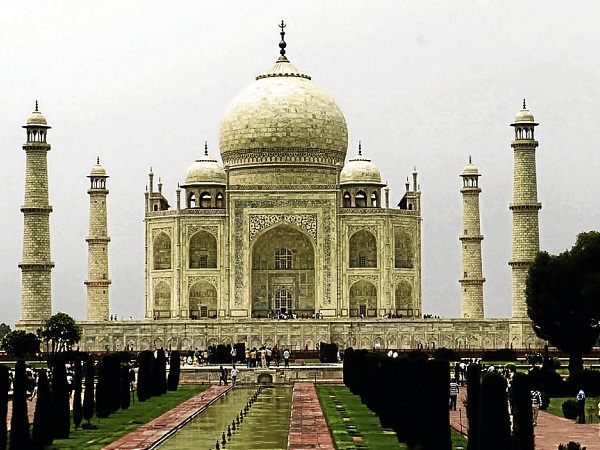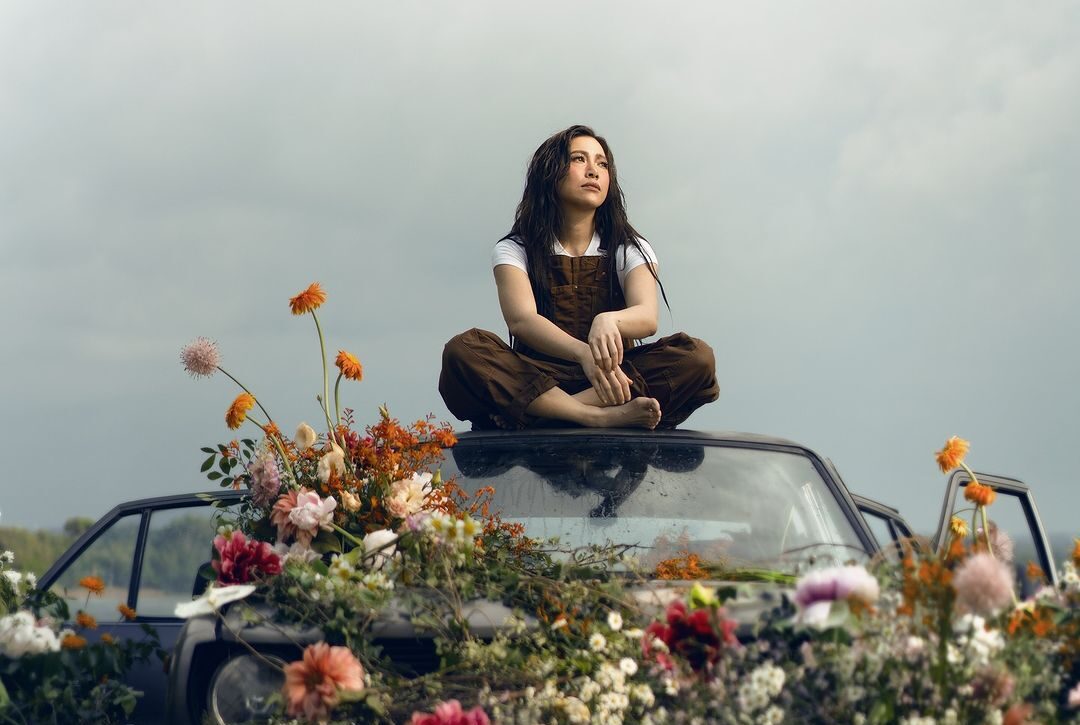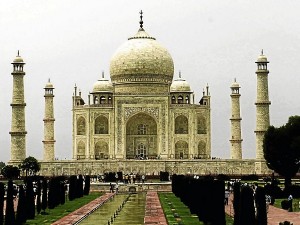 I had been meaning to visit Agra not for romantic but rather for a historic 43rd birthday. Away from home, from my husband and son, family and friends, it is once again, one of my sporadic, if not spontaneous forays at solo traveling. I have intended to leave New Delhi early dawn so I can be in Taj Mahal early morning and take many pictures of the monument at sunrise, as my young Indian friends have suggested.
I had been meaning to visit Agra not for romantic but rather for a historic 43rd birthday. Away from home, from my husband and son, family and friends, it is once again, one of my sporadic, if not spontaneous forays at solo traveling. I have intended to leave New Delhi early dawn so I can be in Taj Mahal early morning and take many pictures of the monument at sunrise, as my young Indian friends have suggested.
My spiritual adviser, Fr. George, a double summa cum laude from two universities in Rome now junior vicar of the Archdiocese of Delhi, advises me against going to Agra alone, much more so leaving before sunrise for safety reasons. So instead of the Agra tour, I settle in Delhi and have some friends in Delhi come over—Sarah and Pierre from France, Carlos and Isabel from Spain and Michelle originally from Oklahoma but worked as a volunteer for maternal and child health care in my hometown in Davao and now stationed in Bihar to partake of my birthday breakfast of pudina paratha and hummus prepared by my New Delhi host’s daughter, Meenal.
Because Father George has yet to free his busy calendar (I have come to visit on such short notice), it takes him days to decide which day he is finally free.
It turns out he can only accompany me two days after. By then, my other friends who have meant to go will have proceeded to Manali, a seaside resort paradise popular among young couples (the wedding scene in the movie “Three Idiots” as evidenced by the red bridal sari, was shot there) and Dharamsala hence I will be left to myself coming back, arriving from Agra to Delhi close to midnight, alone.
Father George turns out to be right. The trip is long and even at daytime, is often punctuated by checkpoints and toll gates, motor registration inspection as the Delhi license plate crosses over to Faridabad and the next few towns until it reaches Agra. There is not much spectacular to see during the long drive—just the usual day market and side street scenes, an aggregate of Indian males fixated over a peddler by the roadside and the surprisingly gleaming road signs of Delhi’s newly annexed cities like Gurgaon and Noida (New Okla Industrial Development Area). And when the traffic gets stalled, hawkers selling live macaque monkeys and plastic dogs with bobble heads, knock on car windows.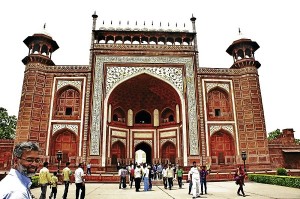
Farther away from the city, the houses become fewer, now replaced by rice paddies and grassy knoll and the occasional grazing grounds.
We arrive in Agra close to noontime. After we are dropped off the street corner I am drowned out by the babble of Korean, Chinese, heavily accented almost unintelligible English, French and other European languages spoken in my midst as other tourists alight from their respective buses.
Father George, unperturbed by the hustle and bustle dismisses my discomfiture. He has been to this place over a dozen times to accompany his friends from the United Nations and other parts of India and Europe. The place is teeming with street hawkers selling soda water in used long neck bottles to bhujia, lime water, pani puri, ice cream, post cards and a motley of souvenirs.
Father pleads with them to stop bothering me as I do not need the souvenirs. I am, after all, he kids them further in Hindi, also a local. It is one of our running jokes when hounded by hassles and touts. Perhaps because of his ministry to the young and his innate charisma, the peddlers leave us in peace.
Taj Mahal the monument is quite a distance from the road where we are so Father George asks if I’d rather take the camel drawn cart or the golf car shuttle. I opt for the latter. After buying the ticket (INR750 for foreigners and INR 20 for locals), after being bodily frisked by a police woman and my bag X-rayed, I am let through.
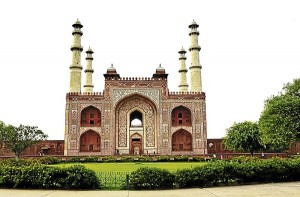 I have to go through a red sandstone gateway before I can see the monument that has captivated the hearts and minds of millions of people around the world. The ancient gate itself is a showcase of Mughal architecture, as is the Taj Mahal and the mosques in the east and the west ends of the complex. The gate, with its symmetrical turrets and chattris, the latter being hallmarks of Rajashtani architecture, serves as a fitting grand entrance to usher one into something much more grandiose a structure. Like a half-opened door that has been parted, the monument is now unveiled in its full splendor and majesty and grace—the imposing immaculate white marble built on equally white platform, the mausoleum which is a fine example of the synthesis of Persian architecture as exemplified by the arched alcoves, corridors and the high double dome—and Indian traditions—the kiosks, which give it a pyramidal outline from distance, the pinnacles that stand proudly guarding it are there for all to see—real, palpable with all of its legend and interwoven stories of love and tragedy.
I have to go through a red sandstone gateway before I can see the monument that has captivated the hearts and minds of millions of people around the world. The ancient gate itself is a showcase of Mughal architecture, as is the Taj Mahal and the mosques in the east and the west ends of the complex. The gate, with its symmetrical turrets and chattris, the latter being hallmarks of Rajashtani architecture, serves as a fitting grand entrance to usher one into something much more grandiose a structure. Like a half-opened door that has been parted, the monument is now unveiled in its full splendor and majesty and grace—the imposing immaculate white marble built on equally white platform, the mausoleum which is a fine example of the synthesis of Persian architecture as exemplified by the arched alcoves, corridors and the high double dome—and Indian traditions—the kiosks, which give it a pyramidal outline from distance, the pinnacles that stand proudly guarding it are there for all to see—real, palpable with all of its legend and interwoven stories of love and tragedy.
From a distance, I take as many pictures as I can. And from where I am, just a few feet from the gateway, leaning against sturdy doors with panels embellished with cartouches I stare and stare both awe struck and seemingly in trance. It is only upon Father’s prodding do I make the two or three hundred meter walk to queue up to the staircase that takes me to the entrance to the tomb of Mumtaz Mahal.
Inside the mausoleum, there is not much save for the crypt draped in canary yellow mesh. Judging from the size of the crypt, she must have been a very tiny woman. The homage to Mumtaz Mahal is quick, after finding my body pressed against other warm bodies of strangers, shoved and squeezed into a tiny perimeter of precious space. After I and Father do one round of the crypt, we head to the exit for a whiff of fresh air and to collect ourselves from the surreal last few minutes.
The magic or call it the mad scramble is over.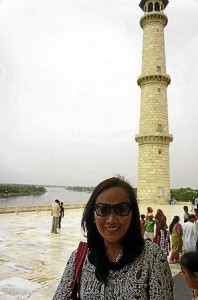
Save for taking pictures with the Yamuna river in the background, west flank, after inspecting the coralline stone inlay that give the glimmer and glint to the marble, after running my fingers over the embossed plant ornaments on marble panels; my date with destiny is done.
It is not difficult to understand why.
After its restoration and after reopening Taj Mahal to the public a few years ago, the magic and the romance, the raison d’ etre for which Shah Jahan built this monument is rekindled and retold and relished. And to us Filipinos. Add to that the much ballyhooed wedding of Robin and Mariel, again either real or imagined.
Most certainly, Taj Mahal is awesome. In fact is it so awesome and beautiful I do not want to even touch it or be near it. The beauty lies in its being viewed in its entirety from a distance, its mystery is of its being a story told and retold a thousand times. To be even close to it is irreverence. That is why my most favorite pictures of the Taj are those I have taken from afar. It is like the ranis of old who, legends say, were so beautiful they should not be seen by the public which accounts for the tiny latticed windows by the palace walls so they can peek and have a look at the halls of private and public audiences without themselves being seen.
That, I believe, is what immortalizes Taj Mahal. I have pieces of advice if you want the magic to remain forever. Etch in memory everything that you see. Capture everything that resonates. Keep everything in your heart.
On our way back to the parking lot the driver asks if I want to go to the Agra Fort. But Fr. George is quick to retort that inasmuch as I have already seen many forts and that the Agra Fort is built by the same emperor that built the Red Fort, I might be more interested to see a monument that, in his words, may even surpass the Taj Mahal though not in the same magnitude as its love story and tragedy but by its grandeur. He then orders the driver to take me to Dayal Bagh.
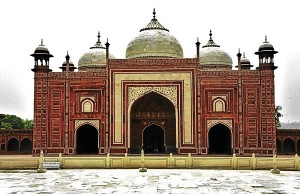 If Taj Mahal awes, a close look at the fine details of Dayal Bagh ’s 110-ft-high memorial that is a combination of temple, gurudwara, vihara and mosque—the town’s centerpiece and top drawer of devotees and tourists alike—wows or bewitches. Dayal Bagh is said to be a pilgrimage site in Agra, that honors Shiv Dayal Sahib, the founder of the Radha Soami Satsang Movement. Started in 1861, his religious philosophy admixes the elements of Hinduism, Christianity, Sikhism and Buddhism—an almost indubitably, inimitable religious tolerance that entices or encourages people of diverse faiths to live in harmony.
If Taj Mahal awes, a close look at the fine details of Dayal Bagh ’s 110-ft-high memorial that is a combination of temple, gurudwara, vihara and mosque—the town’s centerpiece and top drawer of devotees and tourists alike—wows or bewitches. Dayal Bagh is said to be a pilgrimage site in Agra, that honors Shiv Dayal Sahib, the founder of the Radha Soami Satsang Movement. Started in 1861, his religious philosophy admixes the elements of Hinduism, Christianity, Sikhism and Buddhism—an almost indubitably, inimitable religious tolerance that entices or encourages people of diverse faiths to live in harmony.
Found in the outer fringes of Agra, about 13 km from the city center, Dayal Bagh is the site of the memorial built for the spiritual movement Radha Swami. In the temple, in one of the central walls, like a marquee, the encryption is Radhasoami. RS is inscribed in the middle of the arch of the main entrance to the temple. But whatever else the spelling may be, this structure is spellbinding in its beauty; even sophistication and grandeur.
The memorial is made of pure white marble and features numerous pillars and fine pietra dura inlay work on the inner walls.
At the time of my visit, there are few pilgrims and a handful of people, most of them locals, seen praying before spiritual leader’s shrine. Just like most temples, the solemnity of the place clings to you like second skin.
And just like other temples and memorials, shoes are taken off and left with the shoe keeper for free but tips are welcome. A 10 INR tip is said to be generous.
After the Mumbai attack in 2009, the rules here are stricter so that no more photographs are allowed whether it’s from a handheld point and shoot, a DSLR or even a camera phone.
And so Fr. George and I walk barefoot in this memorial. As a very engaging storyteller, he narrates that it has taken this long to build or make that continue to build this temple because among the wishes of the spiritual leader is that only the same family of artisans, spanning generations then, now and until its completion will work on this temple—hew the pillars made of entire slabs of marble, etch and color stain the floral inlays, carve the intricate and colorful ornamental designs Indian art is known for. For this temple is not only a memorial to the great guru but a tribute to the oneness of many tenets—a melding of many hallmarks of each faith—a temple, a gurudwara, vihara even though in these times, may be applied in principle and architectural design alone.
Unlike the Taj Mahal which is most beautiful when viewed in its entirety and from a distance, Dayal Bagh is exactly the opposite. It is only upon close inspection and studied look on every pillar that the Dayal Bagh truly becomes a jaw-dropping experience. Take the case of a column bedecked with roses. It is as though an entire flowerbed of roses has been uprooted, wrapped around the pillar and with divine incantations, turned to marble. Or a marble column becomes enchanted and has grown vines and petals and leaves and quills and tendrils. The sheer intricacy and near perfect resemblance of the most minute detail of a vine’s cursive flick or a leaf serration to what is found in the real reflects that richness of the finest artistic detail that enriches not just the eye but also the spirit.
The craftsmanship is almost beyond human.
This building, according to Fr. George, has been continuously under construction for the past 107 years. Built in 1904, this memorial, up until now, remains to be a work in progress. In and around the memorial, about a dozen disciples continue the construction work with painstaking effort and attention to detail, focused, unmindful of what goes on around them, as though no one else around them exists but their craft.
The sluggishness of the pace with which the construction is ongoing perhaps also has to do with the crude and old fashioned way it is being built. At the time of my visit, artisans still use hand tools to hew and carve, the scaffoldings are made of wood and rusty pulleys are manually hoisted to raise a block of marble. The smaller slabs of white marble are lifted and carried by hand.
It has taken seven years and 20,000 workers to build the Taj Mahal to mark an enduring love. It is estimated that it is likely going to take 80 more years to complete the Dayal Bagh in memory of a beloved spiritual leader and already I feel privileged that a spiritual mover so well loved and popular will also be immortalized by his disciples through this memorial which, while may not be completed in my lifetime or the next, I have had the privilege of having seen being built.
In Sikandra, a suburb of Agra on Mathura Road is another Unesco world heritage site called the Tomb of Aqbar. This is the site of the tomb of Jallludin Akbar, son of Humayun, grandson of Babar who ruled from Kabul to Assam (one of the seven largely Catholic-Christian states in India today) to Kashmir. But his kingdom was built on Indian soil and he was able to “make a nation out of mob” thus earning him the epithet Akbar the Great who ruled in the 16th century as the third Mughal Emperor of India. As ruler of a vast kingdom, he was known for the cities he created, the palaces, and forts that he built and rebuilt and other edifices—among them his own tomb. Even in these modern times, talk of one’s death is taboo if not an altogether eerie, creepy, hair raising experience. But during his time, according to Tartar tradition, it is customary for one to design his own tomb while he is alive.
And so it was Akbar himself who designed his own tomb—conceptualized and had it built during his reign. Not only did he design it, he also decided where he wanted it built—in Sikandra. When he died in 1605 just as the construction of the tomb began, his son Jahangir completed it in 1615.
Unlike Taj Mahal and Dayal Bagh, the buildings in Sikandra are constructed mainly from a deep red sandstone (similar to the tomb of Humayun, the tomb of Akbar’s father in New Delhi) enriched with features in white marble. Decorated inlaid panels of these materials and a black slate adorn the tomb and the main gatehouse. As I inch closer to the gatehouse, I can delineate clearly how each panel is adorned with geometric, floral and calligraphic designs.
The grounds are expansive and laid out as a classic causeway (charbagh) garden style.
That is why, in its vast garden expanse, Father and I see young children play soccer in its grounds. When the ball strayed towards me, I give it a long hard kick and is caught by a boy not quite 9 and with a toothy grin hollered at me “Thanks, man!”
With a love that transcends many lifetimes and languages, spirituality that harmonizes diverse beliefs and more than a modicum of greatness that unifies—the dead long after they have turned to dust or reincarnated into an unpredicted being or wherever your belief makes you think they may be, are immortalized in these monuments of love, reverence and respect.
And these are the reasons why many people in the world—local or otherwise, just has to make that homage to these monuments in Agra.

